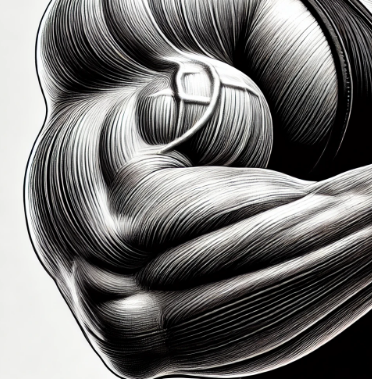Best Bicep Exercises for Mass Using Heavy Weights for Bigger Arms
Published By GainzTracker, 30th September 2024

Building bigger biceps is a goal for many who aim for strong, muscular arms. To develop well-rounded biceps, incorporating heavy weights into your routine is essential. By targeting both the short and long heads of the biceps with compound and isolation movements, you can maximize mass gains. In this article, we’ll go over the best bicep exercises for building mass using heavy weights.
1. Understanding the Biceps
The biceps brachii consist of two heads: the short head and the long head. For a complete bicep workout that focuses on mass, you need to target both heads. Heavier weight training increases muscle tension and promotes hypertrophy, making it ideal for size gains.
2. Barbell Curls
The barbell curl is a staple movement for building bicep mass. It allows you to lift heavier weights, which leads to more muscle fiber recruitment and growth.
- Stand with your feet shoulder-width apart and hold a barbell with an underhand grip, arms fully extended.
- Keep your elbows close to your body and curl the bar upwards towards your chest.
- Lower the bar back down in a controlled manner, extending your arms fully.
Tip: Avoid using momentum to lift the bar; focus on a controlled movement for better muscle engagement.
3. Preacher Curls (Barbell or Dumbbell)
Preacher curls help isolate the biceps and remove the risk of swinging or using momentum. This is a great exercise for focusing on the lower part of the biceps.
- Sit on a preacher bench and hold a barbell or dumbbell with an underhand grip.
- Extend your arms fully, resting them on the pad.
- Curl the weight upwards towards your shoulders, keeping constant tension on your biceps.
- Lower the weight slowly back to the starting position.
Tip: Focus on a slow eccentric (lowering) phase to maximize muscle activation.
4. Concentration Curls
Concentration curls are perfect for isolating one bicep at a time, which helps build a better mind-muscle connection and enhances muscle growth.
- Sit on a bench with your legs spread apart, holding a dumbbell in one hand.
- Place your elbow on the inside of your thigh, allowing the dumbbell to hang towards the floor.
- Curl the dumbbell upwards towards your shoulder, squeezing your bicep at the top.
- Lower the weight back to the starting position slowly.
Tip: Perform slow, controlled reps to focus on maximum bicep contraction.
5. Incline Dumbbell Curls
The incline dumbbell curl puts your biceps in a fully stretched position, which is excellent for targeting the long head and achieving full muscle activation.
- Sit on an incline bench with a dumbbell in each hand, arms fully extended.
- Curl the dumbbells upwards while keeping your elbows in a fixed position.
- Lower the weights slowly back to the starting position.
Tip: Use a full range of motion to stretch and contract the biceps fully for optimal growth.
6. Hammer Curls
Hammer curls are a great exercise for adding mass to both the biceps and brachialis muscles, which give your arms more thickness.
- Stand with a dumbbell in each hand, palms facing your torso (neutral grip).
- Curl the dumbbells upwards while keeping your palms facing each other.
- Lower the weights slowly to the starting position.
Tip: Keep your wrists neutral and avoid swinging the weights for better control and muscle engagement.
Conclusion: Consistency and Progression
To build mass in your biceps, it's important to train consistently with heavy weights and proper form. Incorporating both compound and isolation movements into your routine will help you target all areas of the biceps, ensuring balanced growth. As with any muscle group, progressive overload is key—gradually increasing the weight and intensity over time will lead to significant gains. Make sure to give your muscles time to recover and focus on proper nutrition to fuel muscle growth.
By including these exercises in your workout plan, you’ll be on your way to bigger, stronger biceps that will enhance your overall arm size and strength.
Disclaimer: The information provided in this article is for educational purposes only and is not intended as a substitute for professional medical advice, diagnosis, or treatment. Always consult with a healthcare provider before beginning any exercise program. Use caution when performing exercises to avoid injury.